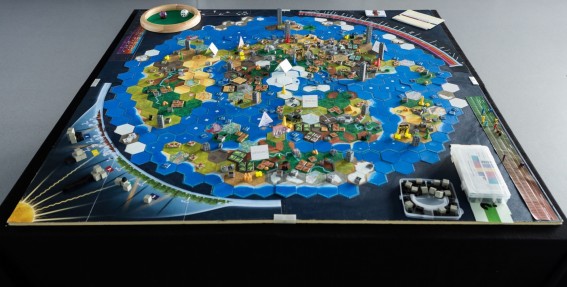„“It is not only for what we do that we are held responsible, but also for what we do not do.“
Molière
The Game
Content and Sequence:
After a preliminary phase spanning from the Neolithic Revolution through industrialisation to the near-present, the game begins in the year 2000. Each round covers a decade; after ten rounds, the game ends in 2100. During these rounds, extreme weather events, environmental disasters, tipping points and social crises may be triggered by the players’ actions. The players must master the challenges while simultaneously transitioning to a sustainable economy and way of life – the fate of humanity lies in their hands.

The 3 Dimensions of the Game
1 Simulation Game
Guided by certified game facilitators in environmental education and skill development, the players assume the roles of global decision-makers and actors from politics, business and civil society. They experience the climate crisis from a global perspective and are confronted with the pressing questions of our time: preserving the Earth’s ecological viability and ensuring the happiness of its inhabitants.
The players learn the varying interests and rationales of the roles and discover that these must be harmonised through compromise and consensus. In the process, the individual interests of each role are confronted with the idea of the common good. As the game progresses, the players soon realise that the climate crisis can only be solved through harmonious and equitable international co-operation.
2 Board Game
In the centre of the room stands the giant game board, like a blue-green jewel floating in space. It reveals the state of the world: gigatons of greenhouse gases in the atmosphere, the advancing destruction of nature and ecosystems through land use and extreme weather events, the sprawling cities and industrial areas, humanitarian crises, and knock-on effects of climate change.
The game board is a scaled-down representation of our world map, featuring climate zones, landscapes and the impact of humans across the globe. Illustrated with over a thousand game pieces, the abstract world climate crisis is made tangible, vivid and captured in all its aspects. The beauty of the illustrations inspires the players to preserve and protect our blue planet, help its inhabitants, and improve their quality of life. From a bird's-eye view, players can look out over the world’s polycrisis and discuss their next moves. What is the smartest strategy? What laws and treaties are necessary? What measures need to be taken to mitigate climate change impacts? What can we do to prevent the climate crisis?
With strategy, negotiation skills and a little bit of luck, each game round becomes a challenge mastered on the road to global sustainability.
3 App and Database
A scientifically-founded simulation calculates the greenhouse gas circulation, where the natural absorption of greenhouse gases by plants and oceans is placed in contrast to human emissions. The IPCC (Intergovernmental Panel on Climate Change) report served as the primary source for the realistic allocation of greenhouse gases to economic sectors and continents.
Players use a web app to control the economic simulation that generates the human emissions. The players must manage and actively shape for example: production methods, the economic locations, tax policy and subsidies, population growth and urban development, consumption patterns and resource extraction, capital and commodity flows.
This is how interests and dependencies are experienced, complexity is clarified and the realistic nature of the simulation is ensured. Players have ten rounds to implement an economically, ecologically and socially sustainable societal and economic order. During each round they receive direct feedback on their actions and measures. The unique combination of board game and digital simulation makes for an immersive and exciting gaming experience.
